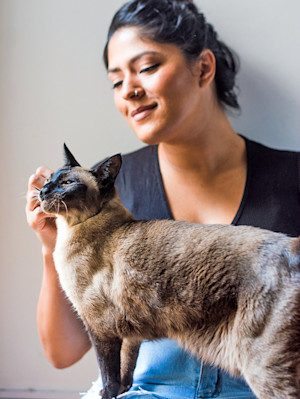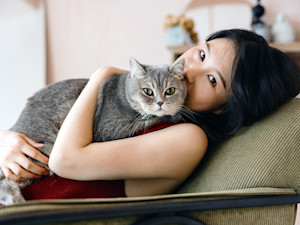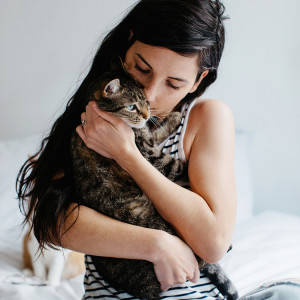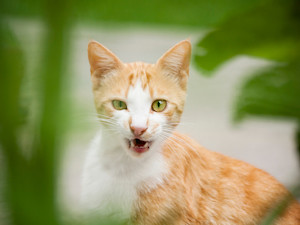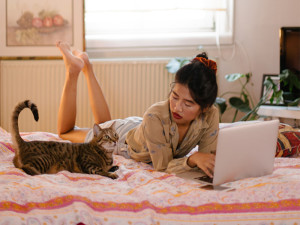Why Do Cats Purr So Much? Find Out the Main Reason for This Behavior
We break down everything you need to know.
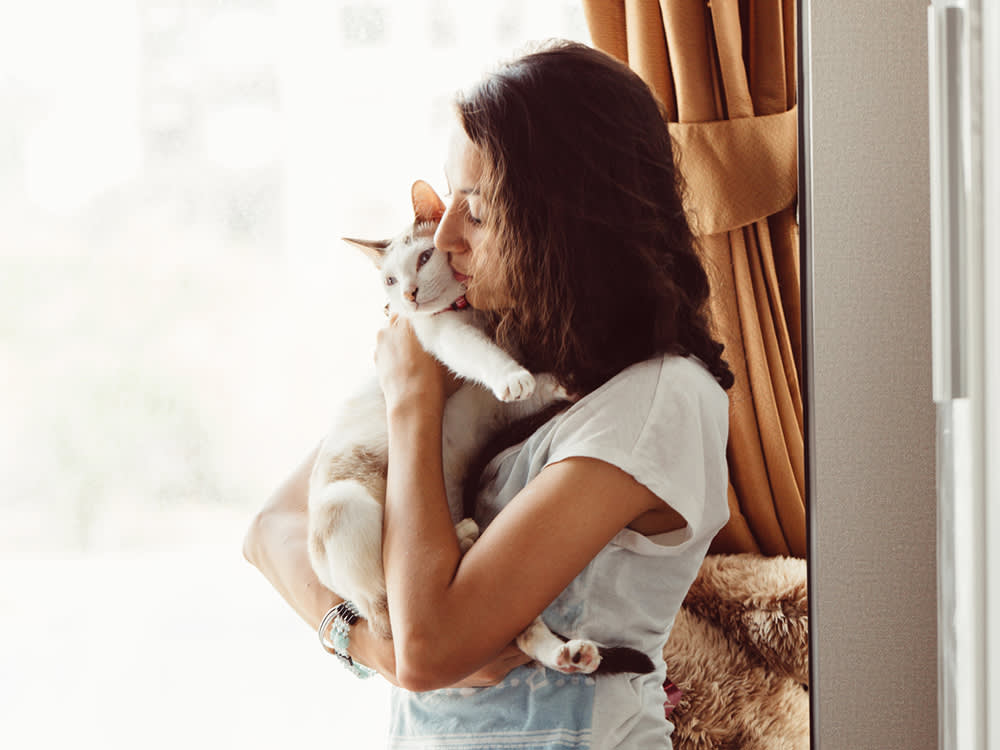
Share Article
In This Article:
Why Do Cats Purr?opens in a new tab When Do Cats Purr?opens in a new tab How Do Cats Purr?opens in a new tab Frequently Asked Questionsopens in a new tab
Cat purring can be puzzling feline behavior: versatile, engaging, and misunderstood. Maybe you’ve noticed that your cat purrs while sitting on your lap, but they also purr in the veterinarian’s office, while their eyes dart all over the place.
Cats purr for various reasons, and you can decode what they mean by studying their body language and unique personality.

littleKin™ is Kinship’s home just for puppy and kitten parents. Bop over to check out expert advice, new pet tools, and special deals—all curated for your newest family member.
opens in a new tabWhy do cats purr?
Cats are born to purr. Many can begin purring at two days old, usually while nursing with their mother cat. Most cats carry “happy purring” into adulthood, but as they grow, so do the reasons for their purring.
1. When they’re content
Is your kitten lounging in their favorite sunny spot? Are they snuggled on your lap, kneading your legs with tiny paws? Their eyes are half-closed, their body language is relaxed, and they’re purring like a finely tuned machine. This is the feline equivalent of contented sighing.
Purring is a sweet way of expressing happiness, security, and love for the moment. It makes cats feel safe, warm, and cozy. So, when your cat purrs with relaxed, contented body language in your presence, please take it as a compliment.
2. When they’re anxious
Not every purr signals moments of bliss. Cats can also purr when stressed or scared (especially in unfamiliar or stressful environments, like the vet). If your cat is purring during a thunderstorm or car ride to get a checkup, they may be trying to self-soothe. Think of it as a feline version of nervous humming or biting your nails.
According to Alisha Kidwell, a veterinarian with over 10 years of experience in North Carolina animal clinics, “Purring can be a coping mechanism for cats. It helps them remain calm during stressful situations.”
3. When they’re greeting you
Have you ever walked through your door to be greeted by a purring, tail-swishing fluffball? Your cat is welcoming you home (and probably asking about dinner). Cats combine purring with other body language and vocalization to greet their favorite people. It’s a charming way to say they care while rolling out the welcome mat.
Here's how to interpret a greeting purr. Your cat has their tail held high with a slight curl to indicate happiness and friendliness. They may rub against your legs, purring the entire time, bumping their head against you in an affection gesture (bunting) that marks you with their scent. Combined with a loud purr, this is a way for cats to reconnect with you when you get home.
4. When they want attention
Cats are masters of manipulation, and purring is one of their sneakiest, most effective tricks for attention. Need proof? Next time your cat purrs while running against your leg, check if they’re angling for food, cuddles, or playtime. This is the feline equivalent of being polite but persistent in demanding your attention.
5. When they’re sick
Here’s where purring can be surprising and a little sad. Cats purr when they’re in pain or distress. And while that may sound counterintuitive, science has suggested that purring may have healing properties. The vibrations between 20 and 150 Hertz are believed to promote bone regeneration and reduce inflammation.
Cats also use purring as a self-soothing mechanism. So, when they feel bad or sick, they’ll purr to make themselves feel more comfortable. A cat recovering from surgery or dealing with an injury may purr to help heal themselves or signal to a human that something is wrong.
When do cats purr?
Cats purr in various situations, from basking in a sunbeam to seeking comfort during tough times. Context is key when interpreting a feline’s purring.
For example, a cat purring while curled up next to you is likely content, while one purring in a strange or stressful environment may be using it as a coping tool. Pay attention to their body language and environment to understand why your cat purrs.
How do cats purr?
The science behind a cat's purring is fascinating. Cats produce a soothing sound from their vocal cords and laryngeal muscles, comparable to humming or gargling water for humans. The muscles vibrate rapidly as the cat breathes, creating a rhythmic hum.
Fun fact: not all felines can purr. Big cats like lions and tigers may roar instead because of differences in their vocal anatomy. So, when your house cat purrs, it’s a unique form of communication.
FAQs
Are cats happy when they purr?
Usually, yes. A purring cat with relaxed, content body language is enjoying life and the moment. However, remember that purring can signal pain or stress, so consider the context and how your cat acts.
Is it normal for a cat to purr constantly?
Frequent purring can indicate happiness, especially during the same action in the same environment. For instance, if your cat constantly purrs when they sit next to you, it’s likely a continuous sign of contentment.
However, consult your veterinarian if your feline’s purring seems excessive or out of place, like during an illness or after an injury.
Why do cats purr when you pet them?
This is one of the ultimate compliments from your cat. Purring during petting means they’re content with, trust, and love you. It signifies affection since they can’t outright verbalize their happiness and adoration.
References
Qureshi, Adnan I, et al. “Cat Ownership and the Risk of Fatal Cardiovascular Diseases. Results from the Second National Health and Nutrition Examination Study Mortality Follow-up Study.” Journal of Vascular and Interventional Neurology, vol. 2, no. 1, 2009, p. 132, pmc.ncbi.nlm.nih.gov/articles/PMC3317329/opens in a new tab.

Valerie Mellema
Valerie Mellema has a Bachelor of Science in Agribusiness and Equine Industry from West Texas A&M University. She has been a professional writer for the past 20 years, covering a wide variety of pet health and care topics before founding a nonprofit focused on mental health in children and thoroughbred aftercare. She has four Border Collies and eight retired racehorses.
Related articles
![Woman petting her Siamese cat on her lap.]() opens in a new tab
opens in a new tabThe Power of Purr: Cats Can Help Heal Themselves With Their Own Purrs
They’re pretty great for people, too.
![Woman hugging her cat at home.]() opens in a new tab
opens in a new tabIf You Think Your Cat Is Manipulating You, You’re Right, Study Says
They know what they are doing when they “cry” for food.
![dark-haired woman hugging cat that has imprinted on her]() opens in a new tab
opens in a new tab10 Signs Your Cat Has Imprinted on You
Feeling like you have a little shadow these days? Here’s why that’s happening.
- opens in a new tab
Why Does My Cat Snore?
It’s normal, except when it’s loud.
![A cat outside showing its bottom teeth.]() opens in a new tab
opens in a new tabWhat’s All the Cat Chatter About?
Scientists believe they could be mimicking the calls of their prey.
![Woman using a laptop in bed, looking at her cat]() opens in a new tab
opens in a new tabWhat to Expect in the First 48 Hours With Your New Cat
Here’s how to help your rescue kitty feel at home.
